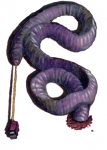Make your purple worm even more dangerous...
http://www.nbcnews.com/science/glue-spitting-velvet-worms-there-are-more-out-there-you-6C10980290#
http://www.nbcnews.com/science/glue-spitting-velvet-worms-there-are-more-out-there-you-6C10980290#
Glue-spitting velvet worms: There are more out there than you think
The new species, Eoperipatus totoros, is the first velvet worm to be described from Vietnam. Velvet worms spit glue from two glands to entangle their prey.
Small bugs of the rain forest have many things to worry about, assuming they are capable of anxiety. But surely some of their more feared predators are velvet worms, a group of ancient animals that spit an immobilizing, gluelike material onto prey before injecting them with saliva and chomping down.
It turns out the velvet worm family is more diverse than thought: A new species has been found in the jungles of Vietnam. Unlike related velvet worms, this species has uniquely shaped hairs covering its body. It reaches a length of 2.5 inches (6 centimeters), said Ivo de Sena Oliveira, a researcher at the University of Leipzig, Germany, who along with colleagues describes the species in Zoologischer Anzeiger (A Journal of Comparative Zoology).
The paper and related work by Oliveira suggest thousands of unknown species of these creatures are waiting to be found throughout the world's tropical rain forests, he said. Research by Oliveira in the Amazon rain forest alone suggests there may be one new species of velvet worm about every 15 miles (25 kilometers), he told LiveScience. [See Amazing Images of Creepy Acorn Worms]
Little-known glue-spitter
The animals are extremely difficult to find and little known, because they spend most of life hidden in moist areas in the soil, in rotting logs or under rocks, due in part to the fact that their permeable skin allows them to quickly dry out, Oliveira said. In some areas, "if you're not there at the right moment of the year, during the rainy season, you won't find them," he added. The rainy season is the one time of year this Vietnamese species exits the soil, he said.
Unlike arthropods (a huge group of animals that includes ants and spiders), velvet worms lack hard exoskeletons. Instead their bodies are fluid-filled, covered in a thin skin and kept rigid by pressurized liquid. This hydrostatic pressure allows them to walk, albeit very slowly, on fluid-filled, stubby legs that lack joints.
Slimed
Their slowness works to their advantage. To hunt, they sneak up on other insects or invertebrates. And that's when the sliming begins — velvet worms like the newfound species hunt by spraying a "net of glue" onto their prey from two appendages on their backs, Oliveira said. This nasty material consists of a mix of proteins that impedes movement. "The more the prey moves, the more it gets entangled," he said.
Oftentimes the velvet worms will eat any excess "glue," which is energetically costly to make. Although the animals have been shown to take down prey larger than themselves, they often choose smaller creatures, likely to ensure they don't waste their precious bodily fluids, Oliveira said.
Fossils show that velvet worms haven't changed much since they diverged from their relatives (such as the ancestors of arthropods and waterbears) about 540 million years ago, Oliveira said. Studies of velvet worms could help shed light on the evolution of arthropods, he added.
There are two families of velvet worm, one spread around the tropics, and another found in Australia and New Zealand. Members of the former group generally tend to be loners. But the other family may be more social. One 2006 study found that members of the species Euperipatoides rowelli can hunt in groups of up to 15, and that the dominant female eats first.
While it's not a surprise to find a new species of velvet worm, this is "great work by (these researchers) to actually characterize and name a new species from this region," said Nick Jeffery, a doctoral student at the University of Guelph who wasn't involved in the study.
The new species, Eoperipatus totoros, is the first velvet worm to be described from Vietnam, said Georg Mayer, a co-author and researcher at the University of Leipzig.
This species was first discovered and listed in a brief 2010 report by Vietnamese researcher Thai Dran Bai, but the present study is the first to describe the Vietnamese animal in detail, Oliveira said.



